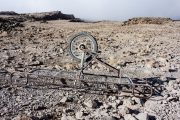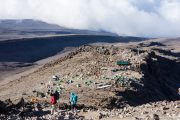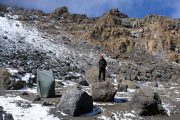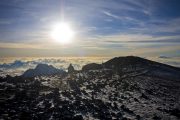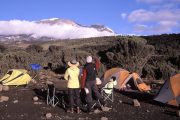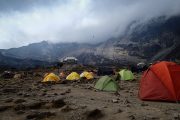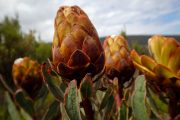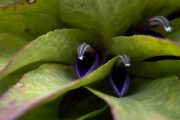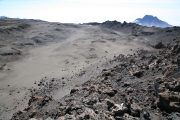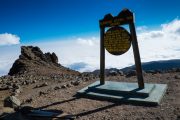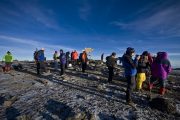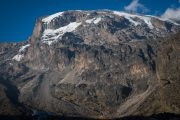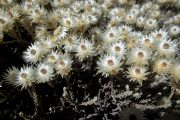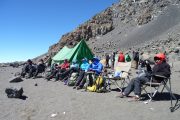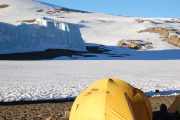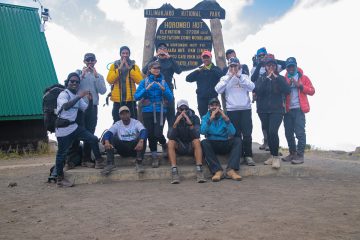Where is the Crater Camp located?
Crater Camp is located within the depression that forms at the summit of Kilimanjaro’s tallest volcanic cone. The campground is a bit lower than Uhuru Peak, Kilimanjaro’s highest point.
Kilimanjaro is made up of three volcanic cones, with Kibo being the highest.
Volcanic cones of Kilimanjaro Mawenzi, Kibo and Shira.
Kibo is not a clean cone, as its top was blown off by a volcanic explosion many years ago. Three concentric craters presently exist at the summit of Kibo:
Uhuru Peak, the highest point on the mountain, is located on the rim of the outermost crater, Kibo Crater, which is roughly 2.5 km wide.
Crater Camp is located in the dip near the summit of Kibo cone.
The Western Breach was formed when the western rim of Kibo Crater fell long ago. This breach may be seen in the photo above.
Crater Camp is located in the main Kibo Crater, directly across from the Furtwangler Glacier. In a minute, we’ll tell you more about this glacier.
On the southern rim of Kibo Crater, Uhuru Peak, Kilimanjaro’s highest peak and summit, is located.
What is the elevation of Crater Camp?
Crater Camp is 5,750 meters (18,865 feet) above sea level.
Uhuru Peak, the highest point on the mountain, is located on the rim of the outermost crater, Kibo Crater, which is roughly 2.5 km wide.
Crater Camp is located in the dip near the summit of the Kibo cone.
The Western Breach was formed when the western rim of Kibo Crater fell long ago. This breach may be seen in the photo above.
Crater Camp is located in the main Kibo Crater, directly across from the Furtwangler Glacier.
On the southern rim of Kibo Crater, Uhuru Peak, Kilimanjaro’s highest peak and summit, is located.
How high is the Crater Camp?
Crater Camp is located at a height of 5,750 meters (18,865 feet) above sea level. Uhuru Peak, the mountain’s summit, is 5,895 meters high (19,340 ft). So you don’t have to descend very far before putting up a tent.
What is the distance from Crater Camp to Uhuru Peak?
Uhuru Peak is located just a short 1 km (0.6 km) disctance northeast of Crater Camp. it would take you about an hour to trek to Uhuru Peak from the Crater Camp on foot.
To sleep in Crater Camp, which route should I take?
We may take customers to Crater Camp via the Lemosho or Northern Circuit. These routes provide excellent acclimatization for a stay at Crater Camp.
What makes Crater Camp unique?
Crater Camp’s major draw is the opportunity to explore the crater throughout the day. The daytime temperatures are moderate, and you may explore the crater at your leisure with virtually no one else around.
Visitors to Kibo Crater may get up-close and personal with phenomena that most people will never see, such as the Furtwangler Glacier reaching for the sky and the steep walls of the dangerous Ash Pit. In addition, when you wake up the next morning, you may take a short stroll to the crater rim for a breathtaking sunrise!
Kibo Crater is absolutely deserted; to set up camp in such a spot is to establish a temporary home in a very hostile environment.
Lunar scenery
Kibo Crater’s lunar-like scenery is captivating. You travel on grey-brown ash, scree, and boulders when the ground is not covered with snow. A small coating of snow in the winter may soften the image and hide its unearthly aspect.
See Mount Kilimanjaro full moon climbs
The ever shrinking Ice fields
The snow on Kilimanjaro’s summit changes with the seasons, but ice fields and isolated glaciers remain permanent. They are, however, tragically shrinking: from 1912 to present, they have lost nearly 80% of their bulk.
While all hikers on Kilimanjaro get to see the Southern Ice Field, those staying in Crater Camp get a better glimpse at the Northern Ice Field, particularly the Furtwangler Glacier.
The famous Furtwangler Glacier
The Furtwangler Glacier is one of Kilimanjaro’s most well-known glaciers. Its closeness to Uhuru Peak is one reason for this. However, most trekkers never get close to it. Crater Camp visitors, on the other hand, get the pleasure of strolling right up to it.
Standing near the base of Furtwangler gives you a feeling of its massive magnitude that others who only see it from afar and above don’t get. You may also enjoy its beautiful blue-and-white splendor up close, and observe the repeating patterns produced by constant exposure to harsh weather and winds.
The Ash Pit
The Ash Pit at Reusch Crater refers to the mountain’s vent and is a sight to behold. The sheer plummet is breathtaking, and the pit serves as a stark reminder of Kilimanjaro’s volcanic past.
Reusch Crater
The Ash Pit is located in Reusch Crater, which is the innermost of three concentric craters on Kibo.
Those staying at Crater Camp who are in good physical condition can do the two- to three-hour roundtrip climb from Crater Camp to Reusch Crater and the Ash Pit. It has to be one of the most spectacular photo opportunities available!
About the Reusch Crater & Ashpit
Expect a rough night.
Crater Camp visitors can expect a rough night. The cold and the high altitude are the two biggest obstacles.
The nights are chilly.
The temperature of Kibo Crater may easily dip below -10°C (14°F) at night, with temperatures as low as -20°C (-4°F).
There’s also the risk of snow. The coldest months are December and January, with the greatest chance of snowfall. Snowfall might make it difficult to see the terrain, so keep that in mind. We strongly advise reading Best time to climb Kilimanjaro before deciding on a month to climb.
Altitude has negative impacts.
There are also the impacts of altitude. Altitude sickness symptoms include dizziness, nausea, headaches, shortness of breath, and poor sleep for everyone staying at Crater Camp. Headaches are very prevalent at Crater Camp, and they may be quite severe.
At Crater Camp, you should anticipate receiving around 10% of your normal amount of sleep. Headaches and nausea are other possible side effects.
Who should spend the night at Crater Camp?
Those who have traveled and slept at high altitude before are better prospects for a Crater Camp stay. These people have a greater understanding of what their bodies are capable of. People who live at a high elevation already have an edge.
We don’t think it’s our place to advocate or discourage you from attending Crater Camp. Everyone is different, and for some, the vistas and experience of spending the night in Crater Camp will outweigh the drawbacks. Others will find the nearly certain headaches, nausea, and insomnia too hard to bear, and they should avoid this alternative. Only you are the expert on yourself.
The Southern Icefield
The Southern Ice is visible and enjoyed by everyone who summits Kilimanjaro.
We won’t take just anyone to Crater Camp, though. Your tour manager will need to know about your high-altitude hiking experience, your comfort with physical discomfort (! ), and your willingness to take risks. Your Mountain guide will also talk to you about the ascending trail you should follow, as you’ll need to climb a route that provides for enough acclimatization.
So, absolutely, we’ll put together a Crater Camp itinerary for those who want it and are up to the challenge. If you’d like to learn more about Crater Camp, please contact us — we’ll be pleased to answer your questions with no strings attached!
Related





